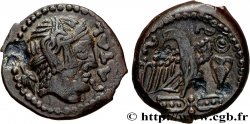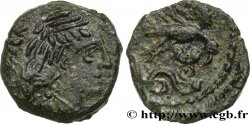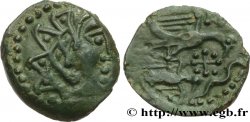bga_330139 - GALLIA - CARNUTES (Area of the Beauce) Quart de statère à la rouelle
недоступный.
Товар уже продан в нашем интернет-магазине (2015)
Цена: : 5 000.00 €
Товар уже продан в нашем интернет-магазине (2015)
Цена: : 5 000.00 €
Тип Quart de statère à la rouelle
Дата: IIe - Ier siècle avant J.-C.
Монетный двор / Город: Chartres (28)
Металл: electrum
Диаметр: 13,5 mm
Ориентация осей монеты: 3 h.
Вес: 1,73 g.
Редкость: R3
Комментарии о состоянии
Monnaie particulièrement intéressante, d’une grande rareté, avec des types de droit et de revers presque complets mais légèrement décentré, sur un flan pourtant large et en assez bon aloi, avec de légers éclatements de frappe
Лицевая сторона
Аверс: легенда: ANÉPIGRAPHE.
Аверс: описание: Tête à droite, particulièrement stylisée, avec une chevelure composite .
Обратная сторона
Реверс: легенда: ANÉPIGRAPHE.
Реверс: Описание: Rouelle à quatre rayons, avec moyeu central, remplaçant le corps d’un cheval dont on distingue les jambes et la tête, très stylisées ; l’ensemble dans un cercle plus important et lui-même entouré d’une suite de petits croissants.
Комментарий
L’exemplaire DT. 2561 repris comme monnaie type est indiqué provenir de l’Est de Châteaudun (Eure-et-Loir) et les auteurs mentionnent un autre exemplaire provenant des environs de Dreux. Ils poursuivent en précisant qu’avec “moins de cinq exemplaire connus, dont deux seulement avec provenance, l’attribution aux Carnutes n’est bien sûr qu’hypothétique.”
Selon le MONETA, ce sont que quatre exemplaires qui sont recensés ; le BN. 10299, le DT. 2651, celui de la vente Bourgey du 6 décembre 1991 et celui de la vente Vinchon du 9 décembre 1997 qui est repris comme monnaie type par le Moneta. Avec l’exemplaire signalé comme provenant de la région de Dreux et cet exemplaire, nous sommes à six exemplaires connus, dont un seul en musée.
Il est intéressant de noter que les trois exemplaires pour lesquels nous disposons d’une photographie (celui de la BN, celui de la vente Vinchon et ce bga_330139) sont tous les trois issus de trois coins de droit différents. Bien que centrés très différemment, le BN. 10299 et l’exemplaire vendu chez Vinchon sont tous deux issus du même coin de revers.
Le droit de notre exemplaire semble moins stylisé que les deux autres (eux-mêmes assez proches), avec une tête facilement reconnaissable. Le revers est quant à lui issu d’un coin différent avec un motif de “pomme de pin” assez nettement visible en deux endroits alors que ce motif semble complètement absent du BN 10299 ou de celui de la vente Vinchon.
Selon le MONETA, ce sont que quatre exemplaires qui sont recensés ; le BN. 10299, le DT. 2651, celui de la vente Bourgey du 6 décembre 1991 et celui de la vente Vinchon du 9 décembre 1997 qui est repris comme monnaie type par le Moneta. Avec l’exemplaire signalé comme provenant de la région de Dreux et cet exemplaire, nous sommes à six exemplaires connus, dont un seul en musée.
Il est intéressant de noter que les trois exemplaires pour lesquels nous disposons d’une photographie (celui de la BN, celui de la vente Vinchon et ce bga_330139) sont tous les trois issus de trois coins de droit différents. Bien que centrés très différemment, le BN. 10299 et l’exemplaire vendu chez Vinchon sont tous deux issus du même coin de revers.
Le droit de notre exemplaire semble moins stylisé que les deux autres (eux-mêmes assez proches), avec une tête facilement reconnaissable. Le revers est quant à lui issu d’un coin différent avec un motif de “pomme de pin” assez nettement visible en deux endroits alors que ce motif semble complètement absent du BN 10299 ou de celui de la vente Vinchon.








 Cообщить об ошибке
Cообщить об ошибке Распечатать страницу
Распечатать страницу Отправить мой выбор
Отправить мой выбор Задать вопрос
Задать вопрос Consign / sell
Consign / sell
 Информация
Информация










